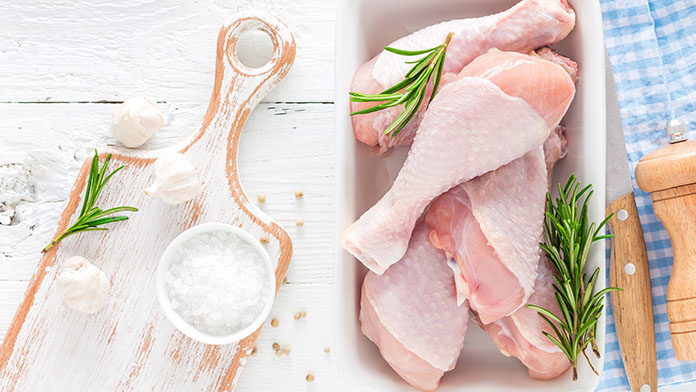Raw chicken: what are the health risks? We return to talk about it after it was served in the canteen of the Stoppani comprehensive school in Milan in recent days. Some volunteer parents of the canteen commission took care of reporting the incident, who first photographed the badly cooked food on the plate and then reported the episode to the competent catering company. Fortunately, none of the children ate their meal and there were no serious consequences. But if they had, what could have happened?
In this article
The case of the English mother
A single bite of raw chicken meat was enough to cause the death of a 37-year-old English tourist, which took place in Corfu in the Ionian sea, a few years ago. After helping herself to the usual buffet of the hotel where she was staying, the woman, on holiday with her husband and her two children, ingested a piece of this uncooked white meat and subsequently began to feel severe abdominal painaccompanied by vomiting with bloody discharge. Within 24 hours, the 37-year-old’s health deteriorated, so much so that, despite being transferred to intensive care, her heart stopped beating. As reported by the Daily Mail, the woman died of an intestinal infection caused by a dangerous strain of Escherichia colibacterium found in chicken.
Raw chicken: risks due to Escherichia coli
To be particularly dangerous for humans are some strains of Escherichia coli (or more simply E. coli), a bacterium normally found in the intestinal bacterial flora of humans and other animals. In most cases it is harmless but some strains, in fact, can cause serious problems to our health, sometimes with fatal results.
Some strains of Escherichia coli are particularly dangerous. Among these is Escherichia coli 0157:H7 which, according to microbiological, clinical and epidemiological studies, represents one of the most dangerous foodborne pathogens. These bacteria produce verocytossine particularly aggressive, which damage the intestinal mucosa and enter the bloodstream, triggering abdominal cramps, vomiting and bloody diarrhea. In some cases they even cause haemolytic uremic syndrome (HUS) and death.
How is Escherichia coli transmitted?
Humans can come into contact with E. coli and its strains through ingestion of contaminated water or food, such as uncooked meats, raw milk, unpasteurized dairy products, vegetables and fruits grown on land fertilized or irrigated with manure from infected cattle farms. Among the potential sources of infection, an increasingly important role is attributed to water sourceswhether they are intended for civil, agricultural or bathing uses. The incubation period of infection with verocytotoxic E. coli, such as E. coli 0157:H7, is included between 1 and 5 days.
How is it treated?
In milder cases, the doctor may suggest rest and fluid replenishment, without opting for pharmacological treatment. If not, he can prescribe one antibiotic therapy. The most used antibiotics in this sense are sulfamethoxazole, cephalosporins, aminoglycosides, fluoroquinolones, ciprofloxacin, nitrofurantoin, ticarcillin and piperacillin.
Prevention
- Meat, especially ground beef and chicken, should be cooked to a minimum internal temperature of 70°C for 2 minutes. You have to make sure that the pink color typical of raw products is no longer inside.
- Consume alone pasteurized milk and dairy products made with pasteurized milk.
- Wash fruits and vegetables thoroughly, especially if they are the kind that are not peeled or cooked.
- The refrigeration below 5°C it prevents the growth of verocytotoxic substances.
- Wash hands thoroughly before handling food and after touching raw meat.
- Wash all thoroughly surfaces and tools who have been in contact with raw meat.
- Use separate chopping boards for meat and other foods.
- Never place cooked meat on plates that have been in contact with raw meat.
Raw chicken: the risks due to Campylobacter
In addition to Escherichia coli, the Campylobacter can cause serious problems to humans. It is a bacterium responsible for campylobatteriosii.e. one of the most widespread gastrointestinal bacterial diseases in the world, which is transmitted through chicken meat, pork and ruminant offal, bivalve molluscs (such as mussels, clams, oysters) consumed raw or badly cooked, and contaminated water and milk .
When the bacterium is transmitted from contaminated food to humans, the infectious gastrointestinal disease campylobacteriosis arises. Its incubation period ranges from one day to one week and the symptoms consist of diarrhoea, abdominal pain, fever, headache, nausea and vomiting. Their duration generally varies from 1 to 7 days, but in 20% of cases it can exceed a week. In less than 1% of cases, especially in children, the elderly and people with immunosuppressed deficits, the disease manifests itself more violently, also triggering meningitis, endocarditis and septic abortions.
How come poultry is contaminated
Poultry represents one of the main reservoirs of the different Campylobacter species and, although knowledge on the contamination routes is still incomplete, it is hypothesized that the factors related to the spread of the bacterium are the level of biosecurity, the season, the age of the poultry, the methods of administering the feed, the transfer of the animals from one farm to another, the conditions of transport of the poultry, the water and the medicines administered to the animals. Contamination of meat occurs during slaughter, through contact with faecal material or through the intestinal contents of animals being slaughtered.
How to cure
After adequate rehydration, patients with campylobacteriosis are usually treated with a antibiotic therapy. The most commonly used antibiotics in these cases are erythromycin, tetracycline and fluoroquinolone.
Prevention
- Meats. Washing meat after slaughter reduces the risk of contamination, as does freezing food products. The only effective method to completely eliminate Campylobacter, however, is cooking the food.
- Latte. The transmission of Campylobacter through milk can be easily controlled by pasteurization.
- Water. A safe drinking water system eliminates the chances of Campylobacter poisoning.
- Clams. The only way not to contract poisoning is to consume them well cooked.

